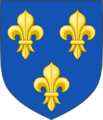Siege of Meaux facts for kids
Quick facts for kids Siege of Meaux |
|||||||
|---|---|---|---|---|---|---|---|
| Part of the Hundred Years' War | |||||||
|
|||||||
| Belligerents | |||||||
| Commanders and leaders | |||||||
| Bastard of Vaurus |
|||||||
| Strength | |||||||
| more than 24,000 men | 1,000 | ||||||
| Casualties and losses | |||||||
| more than 6,000 men | unknown | ||||||
The Siege of Meaux was a long battle that lasted from October 1421 to May 1422. It was fought between England and France during a big war called the Hundred Years' War. The English army was led by their king, King Henry V. King Henry V got very sick during this long winter battle. He sadly died on August 31st because of his illness.
Contents
Why the Siege of Meaux Happened
King Henry V came back to France in June 1421 with 4,000 soldiers. He quickly went to help the Duke of Exeter in Paris. French armies from Dreux, Meaux, and Joigny were threatening Paris, the capital city.
The king attacked and captured Dreux quite easily. Then, he went south, taking Vendôme and Beaugency. After that, he marched towards Orléans. However, he did not have enough supplies to attack such a large and strong city. So, after three days, he went north to capture Villeneuve-le-Roy. Once that was done, Henry marched on Meaux with an army of more than 20,000 men.
The Siege of Meaux: A Long Battle
The town of Meaux was defended by a leader known as the Bastard of Vaurus. People said he was cruel, but he was also a very brave commander. The siege began on October 6, 1421. The English dug tunnels and used cannons to break down the town's walls.
Many of King Henry's friends and allies came to help him. Arthur III, Duke of Brittany, who had just been released from an English prison, came to promise his loyalty to the King of England. He brought his Breton soldiers to fight. Duke Philip III of Burgundy was also there, but many of his men were fighting in other places.
Sadly, many English soldiers got sick during the siege. It is thought that about one out of sixteen soldiers died from diseases like dysentery and smallpox. Thousands more died because the defenders inside the city fought very bravely.
Some important people also died. John Clifford, 7th Baron de Clifford, a brave soldier who had fought in many battles, was killed. Also, 17-year-old John Cornwall, the only son of a famous nobleman, died next to his father. His father saw his son's head hit by a cannonball.
As the siege went on, King Henry himself became very ill. But he refused to leave until the battle was over. Good news reached him from England: on December 6, Queen Catherine had given birth to their son and future king at Windsor Castle.
On May 9, 1422, the town of Meaux finally surrendered. The soldiers defending the castle held out for one more day. But after more attacks, they also gave up on May 10. The siege had lasted for seven months. The Bastard of Vaurus was executed, along with a trumpeter named Orace, who had once made fun of King Henry. John Fortescue was then put in charge of Meaux Castle for the English.
After the Siege: King Henry's Final Days
By the time the siege ended, King Henry was very sick. Soon after the battle, while traveling to Cosne-sur-Loire, he became too weak to ride his horse. He had to be carried to Vincennes, where he arrived on August 10. King Henry V died at Vincennes on August 31, 1422, when he was 35 years old.
Images for kids



